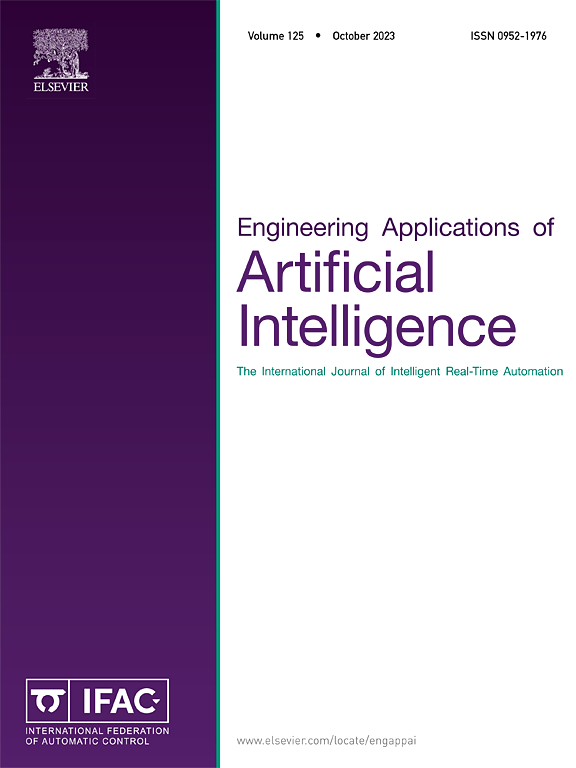Next-generation healthcare: Digital twin technology and Monkeypox Skin Lesion Detector network enhancing monkeypox detection - Comparison with pre-trained models
IF 8
2区 计算机科学
Q1 AUTOMATION & CONTROL SYSTEMS
Engineering Applications of Artificial Intelligence
Pub Date : 2025-02-14
DOI:10.1016/j.engappai.2025.110257
引用次数: 0
Abstract
The rise of digital healthcare has led to the adoption of various technologies aimed at enhancing health operations, patient well-being, and healthcare costs. Digital Twin (DT) technology is a pivotal innovation in this domain. Monkeypox virus (MPXV), a zoonotic virus, poses a significant public health risk, particularly in remote regions of Central and West Africa. Early diagnosis of monkeypox lesions is crucial but challenging due to similarities with other skin conditions. Many studies have employed deep-learning models to detect the monkeypox virus. However, those models often require substantial storage space. This research introduces the Monkeypox Skin Lesion Detector Network (MxSLDNet), an automated digital twin framework designed to enhance digital healthcare operations by enabling early detection and classification of monkeypox and non-monkeypox lesions. Monkeypox Skin Lesion Detector Network (MxSLDNet) significantly advances monkeypox lesion identification, outperforming conventional models like Visual Geometry Group 19 (VGG-19), Densely Connected Network 121 (DenseNet-121), Efficient Network B4 (EfficientNet-B4) and Residual Network 101 (ResNet-101) regarding precision, recall, F1-score, and accuracy, while requiring less storage. This innovation addresses the critical issue of storage demands, making the Monkeypox Skin Lesion Detector Network (MxSLDNet) a viable solution for early monkeypox lesion detection in resource-limited healthcare settings. Utilizing the “Monkeypox Skin Lesion Dataset” with 1428 monkeypox and 1764 non-monkeypox images, Monkeypox Skin Lesion Detector Network (MxSLDNet) achieves high recall, precision, and F1-scores of 0.96, 0.95, and 0.95, respectively. Integrating digital twins into healthcare promises to create a scalable, intelligent, and comprehensive health ecosystem, enhancing treatments by connecting patients and healthcare providers.
下一代医疗保健:数字孪生技术和猴痘皮肤病变检测器网络增强猴痘检测-与预训练模型的比较
数字医疗保健的兴起导致采用各种旨在提高医疗操作、患者福祉和医疗保健成本的技术。数字孪生(DT)技术是该领域的关键创新。猴痘病毒(MPXV)是一种人畜共患病毒,具有重大的公共卫生风险,特别是在中非和西非的偏远地区。猴痘病变的早期诊断至关重要,但由于与其他皮肤病相似,因此具有挑战性。许多研究使用深度学习模型来检测猴痘病毒。然而,这些模型通常需要大量的存储空间。本研究介绍了猴痘皮肤病变检测网络(MxSLDNet),这是一个自动化的数字孪生框架,旨在通过早期检测和分类猴痘和非猴痘病变来增强数字医疗保健操作。猴痘皮肤病变检测网络(MxSLDNet)显著推进了猴痘病变识别,在精度、召回率、f1分数和准确性方面优于传统模型,如Visual Geometry Group 19 (vgg19)、dense - Connected Network 121 (DenseNet-121)、Efficient Network B4 (EfficientNet-B4)和Residual Network 101 (ResNet-101),同时需要更少的存储空间。这一创新解决了存储需求的关键问题,使猴痘皮肤病变检测网络(MxSLDNet)成为在资源有限的医疗环境中早期检测猴痘病变的可行解决方案。利用含有1428张猴痘和1764张非猴痘图像的“猴痘皮肤病变数据集”,猴痘皮肤病变检测网络(MxSLDNet)的查全率、查准率和f1得分分别达到了0.96、0.95和0.95。将数字孪生体集成到医疗保健中,有望创建一个可扩展、智能和全面的健康生态系统,通过连接患者和医疗保健提供者来增强治疗效果。
本文章由计算机程序翻译,如有差异,请以英文原文为准。
求助全文
约1分钟内获得全文
求助全文
来源期刊

Engineering Applications of Artificial Intelligence
工程技术-工程:电子与电气
CiteScore
9.60
自引率
10.00%
发文量
505
审稿时长
68 days
期刊介绍:
Artificial Intelligence (AI) is pivotal in driving the fourth industrial revolution, witnessing remarkable advancements across various machine learning methodologies. AI techniques have become indispensable tools for practicing engineers, enabling them to tackle previously insurmountable challenges. Engineering Applications of Artificial Intelligence serves as a global platform for the swift dissemination of research elucidating the practical application of AI methods across all engineering disciplines. Submitted papers are expected to present novel aspects of AI utilized in real-world engineering applications, validated using publicly available datasets to ensure the replicability of research outcomes. Join us in exploring the transformative potential of AI in engineering.
 求助内容:
求助内容: 应助结果提醒方式:
应助结果提醒方式:


